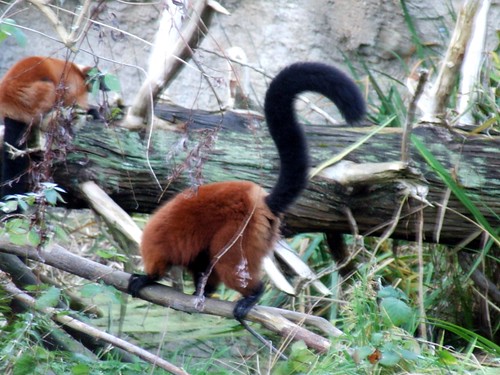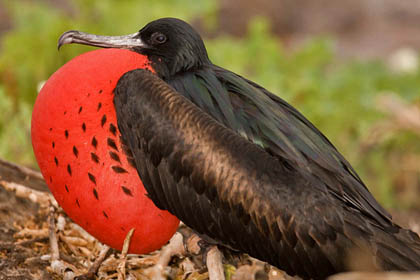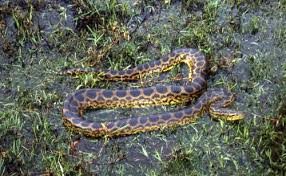Saturday, November 27, 2010
Red ruffed lemur
The red ruffed lemur (Varecia rubra) is a species of lemur found in Madagascar rainforests. It is one of the two species of ruffed lemurs, the other one being the black and white ruffed lemur. It is endangered due to habitat loss and poaching.
Physical Features A red ruffed lemur uses its tail for balancing
The red ruffed lemur can weigh about 3 kilograms. It has a tail which is longer than its body. Its body is 53 centimeters long while the tail is 60 centimeters. Females are larger than males. They have a rusty body color and a ruff near its head with the same color. They have a white or pink patch on their neck. Their stomach, head, feet, tail and the inside of their legs are black in color. They are tree dwelling primates with a cat like nose. They have a long tail to balance themselves while jumping from one tree to another.
Diet
Red ruffed lemurs normally feed on vegetation like flowers, leaves, seeds and fruits. Their favorite food is fig.
Distribution
The red ruffed lemur is endemic to the rainforests of Madagascar like all lemurs. They are mainly found in Eastern Madagascar, in the Masoala National Park.
Threats
The red ruffed lemur has few natural predators. One of their worst natural predator is the fossa. The fossa chases them around tree tops and finally catches them. Humans are another threat to them. Due to poaching and habitat loss, the red ruffed lemur's range has greatly decreased. Their are about 200 red ruffed lemurs in about 42 different zoos worldwide.
Source of picture 1:http://nationalzoo.si.edu/Animals/PhotoGallery/SmallMammals/2.cfm
Source of picture 2:http://www.flickr.com/photos/baggis/2155117471/
Friday, November 19, 2010
Great frigatebird
The great frigatebird (Fregata minor) is a type of sea bird and one of the five species of frigatebird. They are well known for the sac which males inflate only during the breeding season. It is almost found in all tropical oceans. They are rated as least concern by IUCN.
Physical Features
The great frigate bird is a relatively large sea bird with a black body. They measure about 80 to 108 cm from their rather forked like shaped beak till their pointed tail. They have a wingspan of 230 cm or less. Females are larger than males. Great frigatebirds are light birds weighing upto 1 kilogram. Only males have a red gular sac which they inflate during the breeding season. Males have a purplish green shine on their wings and females have a white throat and breast.
Diet
The great frigatebird mainly feed on flying fish and small squids. Great frigatebirds always dives and scoops its prey out of the water. Their diet even consists of tuna and other fish. Sometimes, these frigatebirds even chase other sea birds like boobies to steal their prey. Only females will hunt like this and mainly females do the job of getting food for their young and others.
Distribution
The great frigatebird is found in almost all tropical seas. The highest population is found in the islands of the Pacific ocean. Hawaii is the northmost extent of their range in the Pacific ocean.
Source of picture 1:http://www.kiwifoto.com/galleries/video/great_frigatebird/
Tuesday, November 16, 2010
Northern hairy nosed wombat
The northern hairy nosed wombat (Lasiorhinus krefftii) is a species of wombat. It is critically endangered and found in Australia. It is slightly larger than the common wombat. It is a marsupial
Physical Features
The northern hairy nosed wombat is the largest of the wombats, measuring 3.3 feet (1 meter long) and weighs about 40 kilograms. They are more heavily built tan the other wombats. As they do not have good eyesight, they depend on their sense of smell during the night. They have long claws which are about 5 cm long. Females are larger than males with an extra layer of fat.
Diet
The northern hairy nosed wombat is a herbivore. It feeds on grass and different types of roots. They normally eat in the night as they are nocturnals.
Distribution and Habitat
The northern hairy nosed wombat was once found throughout Victoria, Queensland and New South Wales. Now, it only occurs within 3 square kilometers of the Epping Forest National Park which is only 32 square kilometers. These marsupials live in burrows which takes about one day to make. They have been known to share their burrows.
Common names
The other names for northern hairy nosed wombat are the Banard's hairy nosed wombat, Queensland wombat, Soft furred wombat, Moonie river wombat, Queensland hairy nosed wombat and yaminon.
Reproduction
The northern hairy nosed wombats give birth to about 2 young ones every three years which is a bit faster than the common wombat. They have a gestation period of 21 days. They normally breed during the wet season. The young one will stay in the mother's pouch for 5 to 9 months and will leave the mother after 1 year. Females reach maturity at the age of three while males reach maturity t an age of 2 and sometimes 3.
Conservation Status
The northern hairy nosed wombat is rated as critically endangered by IUCN. Their are only about 100 individuals left. They are endangered due to habitat loss, poaching for skin, introduction of alien species and competition with feral rabbits and other domestic animals.
Source of picture 1:http://thepoormouth.blogspot.com/2008/02/giving-endangered-uncharismatic.html
Saturday, November 13, 2010
Orinoco crocodile
The orinoco crocodile (Crocodylus intermedius) is a species of crocodile found in the Orinoco basin and Meta river. It is critically endangered due to poaching and habitat pollution. It is one of the largest crocodiles, measuring 16 feet.
Physical Features
The length of orinoco crocodiles range from 10 feet to 16 feet, which makes them the fifth longest crocodile. Males are larger than females. Adult females may weigh 200 kilograms while mature males can weigh 380 kilograms. There are reports of orinoco crocodiles exceeding 22 feet, but it is unconfirmed. Orinoco crocodiles have a relatively long snout with a yellowish skin color with dark brown or black bands.
Diet
The orinoco crocodile is a carnivore like all crocodilians. It is considered as an apex predator. Like all crocodilians, it mainly feeds on fish but can also take on other large animals like capybara, domestic animals and even other large predators is food is hard to find. There are not many human attacks.
Distribution
The orinoco crocodile is found in the Orinoco basin and Meta river of South America. It is found in the countries of Venezuela and Colombia.
Conservation Status
The orinoco crocodile is rated as critically endangered in IUCN. The estimated population is a rough 2,500 individuals. As of 2007, there were 50 captive individuals. Some breeding programs release about 360 indviduals a year.
Source of picture 1:http://www.junglexplorer.net/fleuve2_gb.htm
Wednesday, November 10, 2010
African Bush Elephant
The african bush elephant (Loxodonta africana) is a species of african elephant which is also known as the bush elephant or the savanna elephant. It is bigger than the african forest elephant. It is rated as vulnerable in by IUCN.
Physical Features These elephants have muscular trunks
 The african bush elephant stands about 8 to11 feet and weighs 6000 kilograms to 9000 kilograms. Males are bigger than females.They have smoother foreheads than asian elephants. Their big ears cover their shoulder. They have three toes in the back leg, but the front legs, can have four or five. Normally, the tusks are well developed in both males and females. From trunk to tail, african bush elephants have a length of 24 feet. The biggest african bush elephant was shot in 1965. It weighed about 12,000 kilograms and stood 13.5 feet tall.
The african bush elephant stands about 8 to11 feet and weighs 6000 kilograms to 9000 kilograms. Males are bigger than females.They have smoother foreheads than asian elephants. Their big ears cover their shoulder. They have three toes in the back leg, but the front legs, can have four or five. Normally, the tusks are well developed in both males and females. From trunk to tail, african bush elephants have a length of 24 feet. The biggest african bush elephant was shot in 1965. It weighed about 12,000 kilograms and stood 13.5 feet tall.Diet
The diet of these elephants vary depending upon the habitat. Elephants living in grasslands, savannas and forests eat shrubs, trees and different type of herbs. African bush elephants living near Lake Kariba have been known to eat underwater plants. They consume about 150 kilograms of vegetation everyday and drink upto 190 liters of water.
Distribution
The african bush elephant once roamed across Africa in several millions. Now, they are found in southern and eastern Africa. The highest numbers of these elephants are in Botswana, Tanzania, Kenya, Zambia, Zimbabwe and South Africa.
Source of picture 1:http://listsoplenty.com/blog/?p=10165
Source of picture 2:http://www.flickr.com/photos/mikelhendriks/4162101075/
Tuesday, November 9, 2010
African Elephant

The african elephant are species of elephant found in Africa. There are two species recognized. The african elephant is bigger than the asian elephant, making it one of the largest land animal.
Physical Features The trunk of an african elephant.
 Africa elephants are bigger than asian elephants. Males are bigger than females. Males weigh about 6000 kilograms and stand 13 feet tall. Females weigh about 3000 kilograms and stand 8 feet tall. African elephants have bigger ears than asian elephants and they have two finger like lips on their trunk whereas asian elephants have only one. Unlike asian elephants, african elephants have three toes. They have four molars which weigh about 5 kilograms and measure 30 centimeters. Their incisors can weigh 23 kilograms and measure 8 feet. Both male and female have elephant tusks, unlike asian elephants. African elephants about 1,000,000 muscles in their trunk itself
Africa elephants are bigger than asian elephants. Males are bigger than females. Males weigh about 6000 kilograms and stand 13 feet tall. Females weigh about 3000 kilograms and stand 8 feet tall. African elephants have bigger ears than asian elephants and they have two finger like lips on their trunk whereas asian elephants have only one. Unlike asian elephants, african elephants have three toes. They have four molars which weigh about 5 kilograms and measure 30 centimeters. Their incisors can weigh 23 kilograms and measure 8 feet. Both male and female have elephant tusks, unlike asian elephants. African elephants about 1,000,000 muscles in their trunk itselfTaxonomy
African elephants are one of the two surviving genera of the family Elephantidae. There are currently two species of african elephants existing.
1-African bush elephant
2-African forest elephant
The african bush elephant is bigger than the african forest elephant. They were first considered as subspecies of the african elephant, but now they are separate species. Even now, scientists are not sure if they should be considered as separate species or not.
Conservation Status
African elephant numbers have greatly decreased since the twentieth century. In the year 1970, their numbers were more than 400,000. But, by 2006, their numbers were roughly 10,00. African elephants are hunted for their tusks which are used in special chinese medicine and as perfume. Now, due to conservation efforts, the numbers are increasing. In some places, hunters are allowed to hunt a limited number of elephants to control the population.
Diet
African elephants are herbivores. They eat grass and other vegetation. Adults eat almost 150 kilograms of vegetation everyday and 50 tons every year. They drink about 190 liters of water everyday.
Source of picture 1
Source of picture 2
Sunday, November 7, 2010
Yellow anaconda
The yellow anaconda (Eunectes notaeus) is a species of snake found in South America. It is part of the Boidae family like the green anaconda. It is rated as Near Threatened by the IUCN. There are no subspecies found.
Description
The yellow anaconda grow about 10 to 12 feet long which shows that they are not as big as the green anaconda. Females are bigger than males. They normally have a body color of yellow, greenish yellow and golden tan. The yellow anacondas have a series of dark brown or black blotches, saddles, spots and streaks.
Distribution
The yellow anaconda is found in South American countries like Brazil, Bolivia, Paraguay and Uruguay.
Diet
The yellow anaconda eats fish, caiman hatchlings and birds. They kill their prey by coiling their body around their victim and suffocating them to death. Sometimes, larger yellow anacondas, eat deers if it comes to close to the water.
Source of picture 1:http://gallery.usgs.gov/tags/NR2009_10_13/list/10_16_2009_h40Of66eey_10_16_2009_0/1
Saturday, November 6, 2010
Jaguar
The jaguar (panthera onca) is a cat found in rainforests of the Americas. They are the third largest cats, being smaller only to the tiger and lion. It resembles the leopard. They are the only Panthera genus cats found in the Americas. Their range has decreased greatly due to hunting for skin and loss if habitat.
Physical Features
The jaguars can reach a length of 6 feet, making it one of the largest cats. The weight varies depending upon the size. Generally, an adult male weighs about 96 kilograms. Some larger males have been recorded to weigh about 160 kilograms. Whereas, jaguars which are smaller weigh only 36 kilograms. Females are generally 10 to 20% smaller than males. Jaguars have distinct markings on their tan skin color called 'rosettes'. They normally have a tail which is 75 centimeters long. Their body color varies from a tawny yellow to a reddish brown or black. They have rosettes for camouflage in its rainforest habitat. Jaguars are very stocky and have a very powerful jaw. They can carry 360 kilograms with its mouth for 25 feet.
Taxonomy
The jaguars are felines from the genus of Panthera. The subspecies are-
1- Mexican Jaguar
2- Peruvian jaguar
3- Central American Jaguar
4- Arizonian Jaguar
5- Goldman's Jaguar
P. onca is the largest subspecies of jaguar.
Distribution
The jaguar once roamed throughout the Americas. But, recently, due to habitat loss and hunting, they are found in parts of Mexico, through Central America and into South America. They are found in the countries of Venezuela, Belize, Argentina, Brazil, Suriname, French Guiana, Guyana, Bolivia, United States, Honduras, Panama, Costa Rica, Nicaragua, Colombia, Guatemala, Peru, Ecuador and Paraguay.
Conservation Status
The jaguar has greatly decreased in numbers. In 1960, there were about 15,000 jaguars skins brought out from the Amazon in Brazil. It is rated as Near threatened in IUCN Red List. George.W.Bush had done a project to recover the numbers of the jaguars. Now, there numerous breeding programs and the population of jaguars are slowly recovering.
Diet
The jaguar has a carnivorous diet, feeding on capybaras, deers, foxes, dogs and even tapirs. Sometimes, if food is scarce, they may even feed on anacondas. Most of the times, they will catch prey which is easy to kill like frogs, lizards and small mammals, reptiles and amphibians.
Their jaws are powerful even compared to tigers and lions. Their jaw is strong enough to to break bones. They use their jaws to carry their meat to a safer place where no other jaguar can take it.
Source of picture 1:http://www.care2.com/c2c/groups/disc.html?gpp=13579&pst=822116
Subscribe to:
Posts (Atom)







